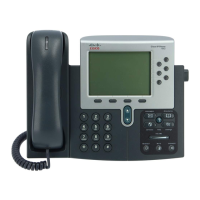1-6
Cisco Unified IP Phone Administration Guide for Cisco Unified Communications Manager 7.1
OL-18913-01
Chapter 1 An Overview of the Cisco Unified IP Phone
What Networking Protocols are Used?
Cisco Discovery Protocol
(CDP)
CDP is a device-discovery protocol that
runs on all Cisco-manufactured
equipment.
Using CDP, a device can advertise its
existence to other devices and receive
information about other devices in the
network.
The Cisco Unified IP Phone uses CDP to
communicate information such as auxiliary VLAN ID,
per port power management details, and Quality of
Service (QoS) configuration information with the
Cisco Catalyst switch.
Cisco Peer-to-Peer
Distribution Protocol
(CPPDP)
CPPDP is a Cisco proprietary protocol
used to form a peer-to-peer hierarchy of
devices. CPPDP is also used to copy
firmware or other files from peer devices
to neighboring devices.
CPPDP is used by the Peer Firmware Sharing
feature.
Dynamic Host
Configuration Protocol
(DHCP)
DHCP dynamically allocates and assigns
an IP address to network devices.
DHCP enables you to connect an IP phone
into the network and have the phone
become operational without your needing
to manually assign an IP address or to
configure additional network parameters.
DHCP is enabled by default. If disabled, you must
manually configure the IP address, subnet mask,
gateway, and a TFTP server on each phone locally.
Cisco recommends that you use DHCP custom
option 150. With this method, you configure the
TFTP server IP address as the option value. For
additional supported DHCP configurations, refer to
the “Dynamic Host Configuration Protocol” chapter
and the “Cisco TFTP” chapter in the
Cisco Unified Communications Manager System
Guide.
Hypertext Transfer
Protocol (HTTP)
HTTP is the standard way of transferring
information and moving documents across
the Internet and the web.
Cisco Unified IP Phones use HTTP for the XML
services and for troubleshooting purposes.
Cisco Unified IP Phones do not support the use of
IPv6 addresses in the URL. You cannot use a literal
IPv6 address in the URL or a hostname that maps to
an IPv6 address.
IEEE 802.1X The IEEE 802.1X standard defines a
client-server-based access control and
authentication protocol that restricts
unauthorized clients from connecting to a
LAN through publicly accessible ports.
Until the client is authenticated, 802.1X
access control allows only Extensible
Authentication Protocol over LAN
(EAPOL) traffic through the port to which
the client is connected. After
authentication is successful, normal traffic
can pass through the port.
The Cisco Unified IP Phone implements the IEEE
802.1X standard by providing support for the
following authentication methods: EAP-FAST,
EAP-TLS, and EAP-MD5.
When 802.1X authentication is enabled on the
phone, you should disable the PC port and voice
VLAN. Refer to the “Supporting 802.1X
Authentication on Cisco Unified IP Phones” section
on page 1-19 for additional information.
Table 1-2 Supported Networking Protocols on the Cisco Unified IP Phone (continued)
Networking Protocol Purpose Usage Notes

